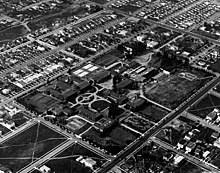East Hollywood, Los Angeles
East Hollywood | |
|---|---|
323 |
East Hollywood is a densely populated neighborhood of 78,000+ residents that is part of the
History

In the early 20th century, the East Hollywood area was a farming village that also encompassed some of what is now
In 1910 the towns of Hollywood and East Hollywood approved annexation to the City of Los Angeles in order to tap into the city water supply. In 1914, Children's Hospital was relocated from downtown LA to Vermont Avenue and Sunset Boulevard.

In 1916 steel magnate
In the early 1920s,
In 1930 Cedars of Lebanon Hospital was formed when Kaspare Cohn Hospital moved from East Los Angeles to a new building on Fountain Avenue and was renamed.
US 101, the Hollywood Freeway, was built between 1947 and 1949.
In the summer of 1999 three Metro Red Line subway stations opened, connecting East Hollywood more efficiently to the rest of the city.
Demographics
The 2000 U.S. census counted 73,967 residents in the 2.38-square-mile East Hollywood
The neighborhood was "moderately diverse" ethnically within Los Angeles, the statistics being
The median yearly household income in 2008 dollars was $29,927, considered low for the city, and high percentages of households earned $40,000 or less. Renters occupied 91.3% of the housing stock, and house- or apartment-owners held 8.7%. The average household size of three people was average for Los Angeles. The percentages of never-married women (33.3%) and men (42.6%) were among the county's highest. One-fifth of the 3,281 families were headed by single parents, a high rate for Los Angeles.[2]
In 2000 there were 1,509 veterans, or 2.8% of the population, a low rate compared with the rest of the city and county.[2]
These were the ten neighborhoods or cities in Los Angeles County with the highest population densities, according to the 2000 census, with the population per square mile:[3]
- Koreatown, Los Angeles, 42,611
- Westlake, Los Angeles, 38,214
- East Hollywood, Los Angeles, 31,095
- Pico-Union, Los Angeles, 25,352
- Maywood, California, 23,638
- Harvard Heights, Los Angeles, 23,473
- Hollywood, Los Angeles, 22,193
- Walnut Park, California, 22,028
- Palms, Los Angeles, 21,870
- Adams-Normandie, Los Angeles, 21,848
Homeless population
In 2022, there were 528 homeless individuals in East Hollywood.[4]
Geography

East Hollywood Neighborhood Council
According to The East Hollywood Neighborhood Council, East Hollywood is bounded by Western Avenue on the west, Hollywood Boulevard on the north, Hoover Street on the east, and the Hollywood Freeway on the south.[5] It contains the following districts:
- District 1: Thai Town
- District 2: Hollymont Junction
- District 3: Hollyset Junction
- District 4: Little Armenia West
- District 5: College Village
- District 6: Virgil Village
Mapping L.A.
According to the
According to the Times, East Hollywood includes the smaller neighborhoods of
Transportation

East Hollywood is served by the Metro B Line subway which runs north–south along Vermont Avenue and east–west along Hollywood Boulevard.
Metro subway stations include:
- Vermont/Beverly
- Vermont/Santa Monica
- Vermont/Sunset
- Hollywood/Western
Over a dozen bus lines run on the major thoroughfares, including
The 101/Hollywood Freeway cuts northwest from downtown Los Angeles, through Hollywood, to the San Fernando Valley.
Education
Thirteen percent of East Hollywood residents aged 25 and older had earned a four-year degree by 2000, an average figure for the city and the county, but the percentage of residents with less than a high school diploma was high for the county.[2]
Schools within East Hollywood's borders are:[8]
Public
|
Private
|
Notable places

- Barnsdall Art Park
- Hollyhock House
- Vista Theatre
- The Braille Institute
- The U.S. National Register of Historic Places
- Church of Scientology West Coast headquarters
- Los Angeles City College
- Self-Realization Fellowship
- Kaiser Permanente Los Angeles Medical Center
- Hollywood Presbyterian Medical Center
- Children's Hospital Los Angeles.
- Zankou Chicken's first American store
Notable people
- Charles Bukowski, writer[9]
- Leonardo DiCaprio, actor and film producer
- Harry Northup, poet and actor
See also
- List of districts and neighborhoods of Los Angeles
- Hollywood, California
- West Hollywood, California
- North Hollywood, Los Angeles
References
- ^ "Worldwide Elevation Finder".
- ^ a b c d e f http://projects.latimes.com/mapping-la/neighborhoods/neighborhood/east-hollywood "East Hollywood," Mapping L.A., Los Angeles Times
- ^ "Population Density". Los Angeles Times. Mapping L.A. Retrieved June 12, 2016.
- ^ "Homeless Count by City/Community". LAHSA. Retrieved 2023-04-14.
- ^ "East Hollywood Neighborhood Council Map". East Hollywood Neighborhood Council. Retrieved 29 October 2020.
- ^ "Neighborhood Council Boundary Map – East Hollywood Neighborhood Council".
- ^ "Hollywood Studio District Neighborhood Council Map" (PDF). hsdnc.org. Retrieved 13 April 2020.
- ^ http://projects.latimes.com/mapping-la/neighborhoods/neighborhood/east-hollywood/schools/ "East Hollywood Schools," Mapping L.A., Los Angeles Times
- ISBN 978-1-900486-28-6. Retrieved 13 August 2012.
External links
- East Hollywood Neighborhood Council
- EastHollywood.net
- "This is East Hollywood", seven-minute video
- [1] East Hollywood crime map and statistics

